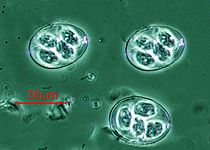Conoidasida facts for kids
Quick facts for kids Conoidasida |
|
|---|---|
 |
|
| Eimeria maxima oocysts | |
| Scientific classification | |
| Domain: | |
| Kingdom: | |
| Superphylum: | |
| Phylum: | |
| Class: |
Conoidasida
|
| Orders | |
|
|
Conoidasida is a group of tiny living things called protists. They are so small you need a microscope to see them! These amazing organisms belong to a larger group known as Apicomplexa.
Most Conoidasida are known for living inside other organisms. They get their food and shelter from their hosts. This way of life is called being a parasite. Don't worry, we'll explain more about that!
Contents
What are Conoidasida?
Conoidasida are a special class of protists. Protists are like the "catch-all" group for living things that aren't animals, plants, or fungi. Conoidasida are part of the Alveolata superphylum. This means they have tiny sacs (called alveoli) just under their outer membrane.
These tiny creatures are known for having a unique structure. It's called an "apical complex." This special part helps them attach to and enter the cells of their hosts. Think of it like a tiny tool kit they carry!
Where Do Conoidasida Live?
Conoidasida live all over the world. You can find them in many different environments. They often live inside the bodies of other animals. This includes animals like birds, mammals, and even insects.
They are very good at adapting to different hosts. Some might live in the gut, while others might be found in other organs. Their ability to live inside various hosts helps them survive and spread.
How Do Conoidasida Get Around?
Conoidasida are not known for moving around a lot on their own. Unlike some other protists that swim with flagella or cilia, Conoidasida usually don't have these. Instead, they often rely on their hosts to move them around.
Their life cycle often involves different stages. Some stages might be passed from one host to another. This can happen through food, water, or even insect bites. It's a clever way for them to travel!
Life Cycle and Reproduction
Conoidasida have complex life cycles. They often go through several different forms. These forms help them survive in different environments. They also help them move between hosts.
They can reproduce in two main ways. One way is called asexual reproduction. This means they make copies of themselves without needing a partner. The other way is sexual reproduction. This involves combining genetic material from two different cells. This mix helps them adapt and evolve.
Why are Conoidasida Important?
Conoidasida play a role in nature. Some species can cause diseases in animals. For example, some types can affect farm animals. This can be a challenge for farmers.
However, studying them helps scientists understand parasites better. This knowledge can lead to ways to keep animals healthy. It also helps us learn more about the amazing diversity of life on Earth.
See also
 In Spanish: Conoidasida para niños
In Spanish: Conoidasida para niños

